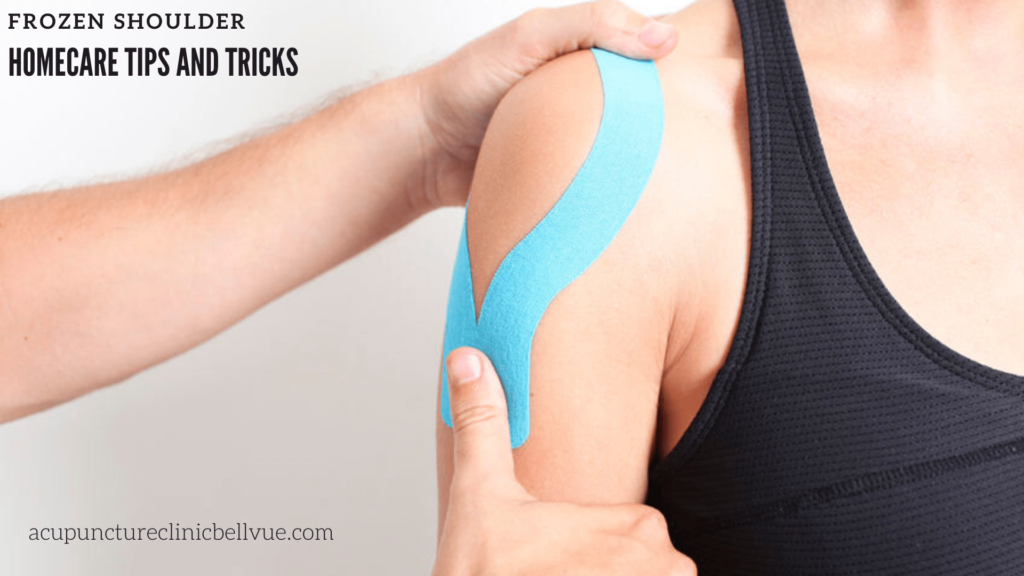Frozen shoulder is a common shoulder pathology that can cause pain, decreased range of motion, disrupted sleep, and a decreased ability to perform basic daily activities. It is a frustrating complaint that has few treatment options from the standard care approach. As an acupuncturist focusing on shoulder pain, I have heard everything from “wait two years, it will just go away” to aggressive procedures that include anesthesia and manual manipulation of the shoulder to quickly reintroduce full range of motion. From my experience, people generally don’t like being told to sit around and do nothing and aren’t fans of unreliable aggressive and painful procedures. So, what can be done to help?
Unfortunately, there is no one shot cure all approach. There are however, options to try that may be very beneficial both at home, or with a professional. It is the health care professional’s duty to meet every patient where they are at when they walk through the door. Recognizing what works for one patient may worsen symptoms of another in regards to movement, is pivotal. That being said, we want to talk about home care options here and only briefly offer options for health care providers.
Frozen shoulder occurs in three stages: freezing, frozen, and thawing. Each of these stages comes with a separate focus. Generally speaking, the freezing stage is painful, the frozen stage is when the least mobility is available, and the thawing stage is the recovery period. Throughout each stage, tolerable movement is key. It is commonly thought that the frequency of tolerable range of motion is useful at increasing speed of healing. So, what are methods of tolerable range of motion?
Initially speaking, exercises to work on include both a wall walk and a pendulum exercise. These exercises don not require any special equipment and can be performed in a pain free manner by most people. The wall walk exercise can be performed in two separate directions, which makes it useful for range of motion. The video below discusses and demonstrates both of these exercises and how you can make them most effective.
If the above exercises worked well or are to easy, then it is time to test out the movements in the video below! You can use a dowel, broom stick, or perhaps a friend to try out these movements. In practice, these are often referred to as proprioceptive neuromuscular facilitation (PNF for short). If these can be performed correctly and pain free, you will note marked improvement in range of motion immediately. It is important to be consistent with the exercises to try and keep progressing. The video below demonstrates how to use this style of stretching with a stick. It is possible to use a home pulley system in a similar fashion as well.
Outside of these exercises, there are other methods of homecare that can be used. Self massage can be very helpful at decreasing pain and increasing range of motion temporarily. Good target muscles to “roll out” include the pectoral muscles and infraspinatus. The videos break down the details on how to perform these easy homecare options, but it is important to note that this should be done in a tolerable manner in regards to pain. These techniques can be performed before and after exercises, but do not go overboard on it beforehand. Utilize quick and light massage techniques to loosen the fascia up versus really working deep into those trigger points when doing before an exercise. Stronger and longer compressions can be used at the end of homecare exercises. If you find self massage to be really helpful, you can consider investing in a ‘Theragun’ or similar machine. They are not an inexpensive investment, but for the patient that really values trigger point work, ‘Theraguns’ provide easy homecare relief. Many local running stores have the option to test them out if your health care practitioner doesn’t have one.
Another excellent homecare option is taping. Taping takes a willing partner, but can be useful at mitigating related pain, aiding in muscle firing during exercise, and temporarily increasing range of motion. There are many different options when it comes to purchasing tapem, but my personal preference is Rock Tape. In the video below, I demonstrate a great approach to taping the shoulder that can be followed along at home!
If you decided to try any of these methods above, let me know how they go by dropping a comment below. If you are inclined to try alternative treatments for your care, Trigger Point Acupuncture can be a very effective method of providing relief and increasing range of motion when combined with the other treatment options discussed above. Obviously, a blog post is not made to be a replacement for seeing professional that can identify your personal needs. Please discuss these options with a licensed health care professional before trying them on your own. Happy healing!

